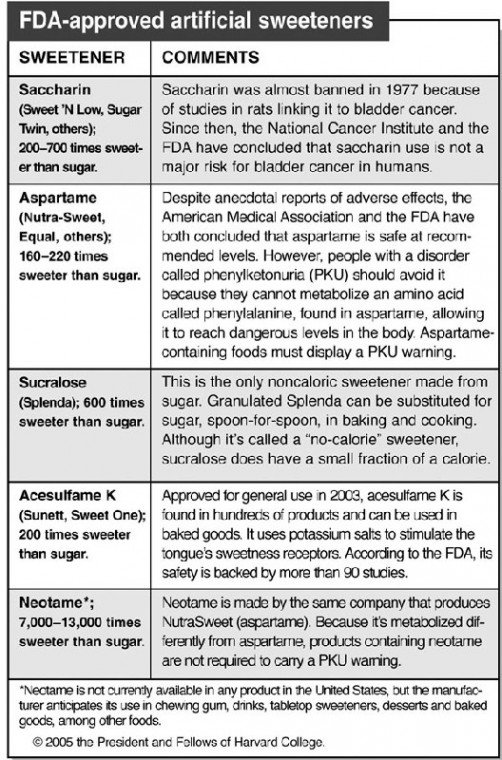Q: I’ve been trying to cut calories by cutting sugar out of my
diet. But to satisfy my sweet tooth, I’ve been leaning on
artificial sweeteners instead. Is it true they’re bad for my
health?
Q: I’ve been trying to cut calories by cutting sugar out of my diet. But to satisfy my sweet tooth, I’ve been leaning on artificial sweeteners instead. Is it true they’re bad for my health?
A: Our appetite for sweet things comes naturally. Newborns favor a sweet taste over bitter or sour, and research on adults suggests that our enjoyment of sweetness is instinctive. About 16 percent of calories in the average American diet come from added sugar (as opposed to sugars found naturally in foods such as fruit).
Most Americans consume excessive amounts of sugar, ingesting the equivalent of 20 teaspoons of sugar a day, much of it in snacks and soda.
A teaspoon of sugar contains only 16 calories, but over the course of a day, the sugar calories that we add to our cereal, coffee and tea – plus the amount contained in many prepared products – can pile up.
Thus, it may make sense to turn to artificial sweeteners, to keep calories under control without giving up some of our favorite foods. In fact, 90 percent of Americans eat low-calorie products, most of which contain one of five artificial sweeteners approved by the Food and Drug Administration. Sugar substitutes also allow people with diabetes to enjoy sweet-tasting foods without the harmful metabolic effects of sugar.
Artificial sweeteners add sweetness without adding calories in two ways. First, they are so sweet – 160 to 13,000 times sweeter than sugar – that you need only a tiny bit to achieve the equivalent taste. You consume a fraction of a calorie to get the sweetness of many more calories worth of sugar.
Second, the body doesn’t fully absorb them and, therefore, doesn’t fully absorb the few calories they contain.
Although FDA-approved and generally accepted as safe, some artificial sweeteners continue to raise concerns about safety. On the one hand, the American Dietetic Association (ADA) recently published a comprehensive report on sugar and artificial sweeteners confirming that artificial sweeteners are safe when used in the amounts specified by the FDA. The ADA also suggests that artificial sweeteners can improve the quality of an individual’s diet, if adding them to fruits, vegetables and whole grains encourages the consumption of healthful foods.
It’s true that some animal research has linked saccharin, the first artificial sweetener, to cancer. Some experts say this is reason enough to ban it. Research published in 1980 found that people who consumed six or more servings of artificial sweeteners (cyclamate and saccharin) or 16 ounces or more of diet drinks daily had an increased risk for bladder cancer.
However, the evidence from their study was not very strong. With rare exceptions and at reasonable levels of consumption, sweeteners appear to pose little or no risk.
In 2001, the government’s National Toxicology Program removed saccharin from its report on carcinogens, where it had been listed as an “anticipated” human carcinogen since 1981.
Cancer experts now say that the chance of a person getting cancer from an artificial sweetener is quite low. But more research is needed, since so many of us are raised on many products containing artificial sweeteners.
Artificial sweeteners like saccharin and sucralose can be useful for weight or blood-sugar control, yet there are alternatives. You can train yourself to appreciate unsweetened flavors. Try going without a sweetener in your coffee or cereal. Rather than diet soda, choose lightly flavored sparkling water. Eat smaller portions of the sweet foods you like instead of huge quantities of their sugar-free substitutes.
While artificial sweeteners seem fine in moderation, don’t lean on them too heavily.
Submit questions to the Harvard Medical School Adviser at www.health.harvard.













